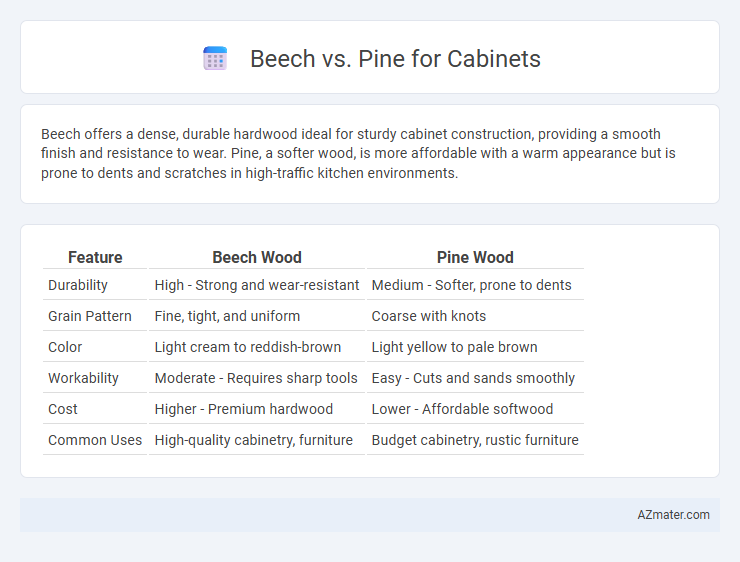Beech offers a dense, durable hardwood ideal for sturdy cabinet construction, providing a smooth finish and resistance to wear. Pine, a softer wood, is more affordable with a warm appearance but is prone to dents and scratches in high-traffic kitchen environments.
Table of Comparison
| Feature | Beech Wood | Pine Wood |
|---|---|---|
| Durability | High - Strong and wear-resistant | Medium - Softer, prone to dents |
| Grain Pattern | Fine, tight, and uniform | Coarse with knots |
| Color | Light cream to reddish-brown | Light yellow to pale brown |
| Workability | Moderate - Requires sharp tools | Easy - Cuts and sands smoothly |
| Cost | Higher - Premium hardwood | Lower - Affordable softwood |
| Common Uses | High-quality cabinetry, furniture | Budget cabinetry, rustic furniture |
Introduction to Beech and Pine for Cabinets
Beech wood is valued for its fine, tight grain and light color, offering durability and a smooth finish ideal for cabinet making. Pine, a softwood, features a prominent grain pattern and knots that deliver a rustic aesthetic while being lightweight and cost-effective. Both woods provide distinct textures and characteristics, influencing cabinet design choices based on style preference and budget.
Appearance and Grain Patterns
Beech wood features a fine, uniform grain with a pale cream to pinkish-brown hue, offering a smooth and consistent appearance ideal for modern or minimalist cabinets. Pine wood presents a more pronounced grain pattern with knots and a warm, yellowish tone that adds a rustic and natural charm to cabinetry. The choice between beech and pine hinges on whether a sleek, subtle texture or a lively, character-filled look is desired for the cabinet design.
Durability and Hardness
Beech wood offers superior durability and hardness compared to pine, making it ideal for cabinetry that withstands daily wear and tear. With a Janka hardness rating of approximately 1,300, beech is significantly harder than pine, which typically rates around 420 to 870 depending on the species. This enhanced hardness ensures beech cabinets resist dents and scratches better, providing a longer-lasting, more resilient surface.
Cost Comparison
Beech cabinets typically cost more than pine due to beech's higher density and durability, which contribute to a longer lifespan and premium finish. Pine is generally more affordable, making it a popular choice for budget-conscious projects, but it is softer and more prone to dents and scratches. The initial cost savings with pine may be offset by potential maintenance and refinishing costs over time compared to the more resilient beech.
Workability and Machinability
Beech wood offers superior workability for cabinets due to its uniform texture and fine grain, allowing for smooth sanding and clean edges. Pine, while softer and easier to machine, tends to splinter and dent more easily, which can complicate precision cuts and detailing. The dense hardness of beech enhances its machinability, providing consistent results with power tools compared to the variable softness of pine.
Staining and Finishing Options
Beech wood offers a smooth, fine grain that accepts stains evenly, resulting in a consistent, polished finish ideal for cabinets seeking a classic or contemporary look. Pine features a more porous texture with prominent knots that can absorb stains unevenly, often requiring pre-treatment or gel stains to achieve a uniform color. Both woods can be finished with clear coats, lacquers, or varnishes to enhance durability and highlight natural grain patterns, but beech's dense structure typically yields a more refined finish.
Environmental Impact and Sustainability
Beech wood offers a moderate environmental impact as it is sourced from sustainable European forests with efficient growth cycles, making it a renewable option for cabinetry. Pine has a lower environmental footprint due to its rapid growth and widespread availability in temperate regions, enabling quicker forest regeneration and carbon sequestration. Choosing pine cabinets supports sustainable forestry practices, whereas beech provides durability with a slightly higher resource demand, balancing longevity and ecological considerations.
Suitability for Different Cabinet Styles
Beech wood offers a smooth, uniform grain ideal for contemporary and minimalist cabinet styles, providing a clean and elegant appearance. Pine, with its natural knots and rustic texture, suits traditional, country, or farmhouse cabinets, adding warmth and character. The durability of beech supports sleek designs, while pine's softness allows for more intricate, hand-crafted detailing.
Maintenance and Longevity
Beech cabinets offer high durability and resist dents and scratches better than pine, requiring less frequent maintenance over time. Pine, being softer and more porous, is prone to dents and may need regular refinishing or sealing to maintain its appearance. Longevity for beech cabinets typically surpasses pine due to its dense grain structure, making it a preferred choice for long-term investment in cabinetry.
Final Recommendation: Beech or Pine?
Beech offers exceptional durability and a fine, even grain that enhances cabinet longevity and aesthetic appeal, making it ideal for high-traffic kitchen environments. Pine, while more affordable and lightweight, tends to be softer and more prone to dents, suitable for rustic or budget-friendly cabinetry but less durable over time. For long-lasting, high-quality cabinets, beech is the superior choice due to its strength, wear resistance, and smooth finish.

Infographic: Beech vs Pine for Cabinet
 azmater.com
azmater.com